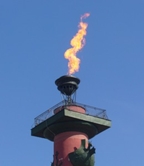 Kazansky CathedralKazansky Cathedral (Cathedral of Our Lady of Kazan) designed and erected in 1801-1811 by the architect Andrei Voronikhin. The architect has created a magnificent edifice (height-71.6 m, length72.5 m). with its main building facing onto Nevsky Avenue. The cathedral with its semicircular Corinthian colonnade (96 thirteen-metre-high columns) is the dominant feature in one of the most elegant squares of the city.
Huge bas-reliefs, approximately 15 metres long and almost two metres high, depicting Biblical subjects, grace the two butt-ends of the building facing onto Nevsky Avenue. The bas-relief above the left butt-end of the building was executed by the famous Russian sculptor Ivan Martos on the subject Moses Parting the Waters, the one above the right butt-end is a depiction of the Brazen Serpent by the sculptor Ivan Prokofyev.
In the niches of the northern portico (facing onto Nevsky Avenue) bronze sculptures have been mounted: Prince Vladimir (in the period of his rule in Kiev, in approximately 988, when Christianity was adopted in Russia)-sculptor Stepan Pimenov; John the Baptist-sculptor Ivan Martos; Alexander Nevskysculptor Stepan Pimenov; and St. Andrew-sculptor Vasily Demut-Malinovsky. The bronze doors of the northern portico, consisting of ten multifigured compositions taken from the Bible are particularly worthy of attention. This is an exact copy of the doors created in the mid-15th century by the Italian sculptor Lorenzo Giberti for the Florentine Baptistery. It took Giberti 27 years to create his work of art. Michelangelo said of these doors that they were splendid enough to serve as the gates of paradise. Gypsum models of the doors were preserved in 5t. Petersburg in the Academy of Arts and from them the founder Vasily Yekimov made the doors for the Kazansky Cathedral.
After Russia's victory over Napoleon in 1812 the cathedral became a unique monument to Russian military glory. The standards taken as trophies and the keys from the fortresses captured by the Russian forces were displayed here. In the vault of the northern chapel by the wall (to the right of the entrance) lies the grave of Mikhail Kutuzov, the commander of the Russian forces, who died in 1813. He was buried on the spot where he prayed before he left to join his army in the field.
In 1837, when the 25th anniversary of the rout of Napoleon's troops in Russia was celebrated, statues of Mikhail Kutuzov and Mikhail Barklai de Tolli were erected in front of the cathedral. These statues were the work of the sculptor Boris Orlovsky and the architect Vasily Stasov. |
 Сайт сделан под разрешение экрана 1280 на 800. Если страницы отображаются некорректно, настройте разрешение экрана: Рабочий стол-правая кнопка мыши-свойства-параметры-разрешение экрана. |
|
|
|
|






